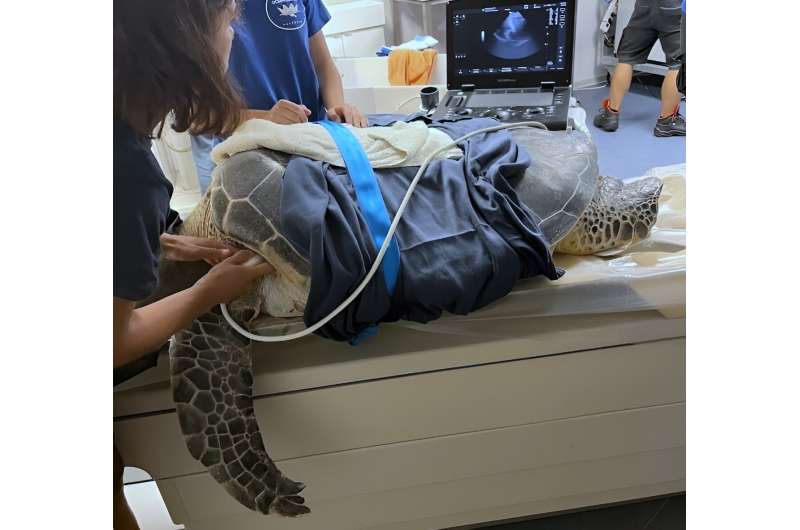This article has been reviewed according to Science X's editorial process and policies. Editors have highlighted the following attributes while ensuring the content's credibility:
fact-checked
trusted source
proofread
Veterinarians team up with fishers to evaluate the health of accidentally caught sea turtles

Six out of seven sea turtle species are endangered, and humans are primarily responsible. Commercial fishing activities are the largest human-caused disturbance to sea turtles due to accidental capture.
Fishers are typically unaware if a sea turtle is caught in their net until it's completely pulled out of the water. However, releasing sea turtles without veterinary evaluations can be harmful. When accidentally caught, the turtles' normal diving processes are interrupted, which can cause abnormal gas, gas emboli, to form in their organs. Veterinarians around the globe are working to understand the possible consequences of this pathology and determine the best treatment for turtles depending on when they surface. Here, they used ultrasound imaging to get a closer look at sea turtles' bodies in real time, focusing on the heart, liver, and kidney.
Katherine Eltz, a first-year doctoral student at the University of North Carolina at Chapel Hill, has determined that there are ways to differentiate gas levels over time in sea turtles. Eltz, whose home laboratory focuses on ultrasound imaging for decompression sickness mitigation in humans, collaborated with veterinarians who measured gas emboli in turtles in real time on fishing boats. She presented her work Monday, May 13 as part of a joint meeting of the Acoustical Society of America and the Canadian Acoustical Association, running May 13-17 at the Shaw Centre located in downtown Ottawa, Ontario, Canada.
"Veterinarians can examine whole-body MRI or X-ray scans and find specific bubbles in a variety of different organs," said Eltz. "The benefit of ultrasound is that we can see bubbles flowing through vessels or stationary in tissues. The portability of ultrasound means that it can be brought onto fishing boats, which we took advantage of to collect half of the data used in this project."
Her collaborators from the Oceanogràfic Foundation were the first to report decompression sickness in turtles. Eltz examined ultrasound data collected from sea turtles found off the coast of Brazil, Italy, and Spain, though this issue is found in sea turtles worldwide. The data collection from Eltz's collaborators at Oceanogràfic comes from veterinarians who joined fishers off the coasts of these countries and imaged the turtles immediately to monitor their bubbles after surfacing.
Eltz's results come from two experimental groups with different circumstances regarding time and gas severity. The brightness from the ultrasounds taken from the groups is a valuable quantitative metric to separate each ultrasound by grade. These findings can help veterinarians better treat sea turtles presenting with gas embolism. Ultrasound brightness could become a quantitative metric for veterinarians to determine which turtles need hyperbaric oxygen treatment and which can be released.
"The largest task still at hand is to work towards standardizing the acquisition of the ultrasound data collected for this project," said Eltz. "Now, I can work with veterinarians to help adjust their methods, including improved image processing to standardize the data in post-processing."
With a rich dataset from Oceanogràfic at her disposal, Eltz hopes to examine other possible factors that may be related to gas severity. These insights all help lead to better prediction of the outcomes for bycaught sea turtles.
More information:
Main meeting website: acousticalsociety.org/ottawa/
Technical program: eppro02.ativ.me/src/EventPilot … r.php?id=ASASPRING24
Provided by Acoustical Society of America



















